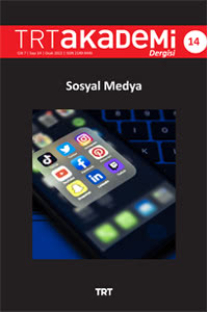İkinci Dünya Savaşı'nda Japon Radyo Propagandasına Yönelik ABD Karşı Propagandası: "Tokyo Woes" Çizgi Filmi Üzerine İnceleme
Radyo, Radyo Yayıncılığı, Çizgi Film, Propaganda, ABD, Japonya, İkinci Dünya Savaşı, Göstergebilimsel Analiz
The USA Counter Propaganda Against Japanese Radio Propaganda in the Second World War: The Examination on Cartoon "Tokyo Woes"
Radio, Propaganda, Short Film, Nazi Germany, The United Kingdom,
___
- Boyd, D. A. (1983). Radio Free America: The U.S. Government's Reaction to Pirate Radio, Central States Speech Journal, 34:3, 203-209.
- Brown, R. J. (2004). Manipulating the Ether: The Power of Broadcast Radio in Thirties America. The United States: McFarland.
- Castaneda Paredes, M. (2003). The Transformation of Spanish-Language Radio in the US. Journal of Radio Studies, 10(1), 5-16.
- Craig, D. B. (2000). Fireside Politics: Radio and Political Culture in the United States, 1920-1940. The United States: JHU Press.
- Craig, S. (2001). "The Farmer's Friend": Radio Comes to Rural America, 1920–1927. Journal of Radio Studies, 8(2), 330-346.
- Craig, S. (2006). "The More They Listen, the More They Buy" Radio and the Modernizing of Rural America, 1930-1939. Agricultural history, 1-16.
- Crawford-Franklin, C., & Robinson, L. (2013). “Even in an Age of Wonders”: Radio as an Information Resource in 1920s America. Journal of Documentation, 69(3), 417-434.
- Culbert, D. H. (1976). News for Everyman: Radio and Foreign Affairs in Thirties America. ABC-CLIO.
- Daniels, G. (1982). Japanese Domestic Radio and Cinema Propaganda, 1937–1945: an Overview. Historical Journal of Film, Radio and Television, 2(2), 115-132.
- Delporte, C. (2001). Humour as a Strategy in Propaganda Film: the Case of a French Cartoon from 1944. Journal of European Studies, 31(123), 367-377.
- Dinsman, M. (2015). Modernism at the Microphone: Radio, Propaganda, and Literary Aesthetics During World War II. The United Kingdom: Bloomsbury Publishing.
- Doherty, M. (1994). Black Propaganda by Radio: the German Concordia broadcasts to Britain 1940–1941. Historical Journal of Film, Radio and Television, 14(2), 167-197.
- Doherty, M. A. (2000). Nazi Wireless Propaganda: Lord Haw-Haw and British Public Opinion in the Second World War. The United Kingdom: Edinburgh University Press..
- Douglas, S. J. (2013). Listening in: Radio and the American Imagination. The United States: U of Minnesota Press.
- Engelman, R. (1996). Public Radio and Television in America. The United States: Sage.
- Fandom (2019). "Tokyo Woes Çizgi Filmi", https:// looneytunes. fandom. com/ wiki/ Tokyo _Woes, Erişim Tarhi: 01.11.2019.
- Funk, C. (1998). The Art in America Radio Programs, 1934–1935. Studies in Art Education, 40(1), 31-45.
- Garay, R. (1995). Guarding the Airwaves: Government Regulation of World War II American Radio. Journal of Radio Studies, 3(1), 130-148.
- Grubbs, J. (2004). Women Broadcasters of World War II. Journal of Radio Studies, 11(1), 40-54.
- Hand, R. J. (2012). Terror on the Air!: Horror Radio in America, 1931-1952. The United States: McFarland.
- Hilmes, M. (1997). Radio Voices: American Broadcasting, 1922-1952. The United States: U of Minnesota Press.
- Horten, G. (2003). Radio goes to War: The Cultural Politics of Propaganda during World War II, The United States: University of California Press.
- Houswitschka, C. (2003). Nazi Wireless Propaganda. Lord Haw-Haw and British Public Opinion in the Second World War.(International Communications), Jahrbuch für Kommunikationsgeschichte, 253-255.
- IMDB (2019a). “AxisSally”, https:// www. imdb. com/ title /tt7050946/, Erişim Tarihi: 01.11.2019.
- IMDB (2019b). "Nimbus Libéré Çizgi Filmi", https:// www. imdb. com/ title/ tt0228643/, Erişim Tarihi: 07.12.2019.
- IMDB (2019c). "Tokyo Woes Çizgi Filmi", https:// www. imdb. com/ title/ tt0293957/, Erişim Tarihi: 07.12.2019.
- Jones, C. C. (1988). Class Tax to Mass Tax: The Role of Propaganda in the Expansion of the Income Tax during World War II. Buffalo Law Review, 37(3), 685-738.
- Kalkan Kocabay, H. (2008). Tiyatroda Göstergebilim. İstanbul: E Yayınları.
- Keegan, J. (2016). İkinci Dünya Savaşı, Çev. Samet Öksüz, İstanbul: Say Yayınları.
- Looneytunes (2019). "Tokio Jokio Çizgi Fimi", https:/ /looneytunes. fandom. com/ wiki/ Tokio_ Jokio?file =LOONEY _TUNES _Tokio _Jokio _(WW2_Racist) _(1943) _(Remastered) _(HD_1080p), Erişim Tarihi: 01.11.2019.
- Masaharu, S. (1999). 'Negro Propaganda Operations': Japan's Short-Wave Radio Broadcasts for World War II Black Americans. Historical Journal of Film, Radio and Television, 19(1), 5-26.
- Mizuno, T. (2013). An Enemy's Talk of “Justice” Japanese Radio Propaganda against Japanese American Mass Incarceration during World War II. Journalism History, 39(2), 94-103.
- Phipps, S. P. (1991). The Commercial Development of Short Wave Radio in the United States, 1920–1926. Historical Journal of Film, Radio and Television, 11(3), 215-227.
- Raiti, C. G. (2007). The Disappearance of Disney Animated Propaganda: A Globalization Perspective. Animation, 2(2), 153-169.
- Rifat, M. (2013). Açıklamalı Göstergebilim Sözlüğü: Kavramlar, Yöntemler, Kuramcılar, Okullar. İstanbul: Türkiye İş Bankası Kültür Yayınları.
- Schiffer, M. B. (1991). The Portable Radio in American Life. The United States: University of Arizona Press.
- Sharon Wang, S., & Hong, J. (2011). Voice of America in the Post-Cold War Era: Opportunities and Challenges to External Media Services via New Information and Communication Technology. International Communication Gazette, 73(4), 343-358.
- Sığırcı, İ. (2016). Göstergebilim Uygulamaları, Metinleri, Görselleri ve Olayları Okuma. Ankara: Seçkin Yayıncılık.
- Smith, B. L., & Brigham, J. C. (1992). Benchmark: Native Radio Broadcasting in North America: An Overview of Systems in the United States and Canada. Journal of Broadcasting & Electronic Media, 36(2), 183-194.
- Smulyan, S. (1993). Radio Advertising to Women in Twenties America: “A Latchkey to Every Home”. Historical Journal of Film, Radio and Television, 13(3), 299-314.
- ISSN: 2149-9446
- Yayın Aralığı: 3
- Başlangıç: 2016
- Yayıncı: TRT
Radyo genel bir kültür kutusudur
Joseph Goebbels'in Radyo Propagandasının Mizah Çekiciliği Bağlamında Karikatürlerdeki Sunumu
Örgütsel Ekoloji Kuramı Açısından Türkiye’deki Kamu Radyoları ve Özel Radyoların Analizi
Joseph Goebbels'in Radyo Propagandasının Mizah Çekiciliği Bağlamında Karikatürlerdeki Sunumu
Kısa Dalga Savaştan Soğuk Savaşa, Uluslararası Radyo Yayıncılığı
Neslihan DEĞİRMENCİOĞLU, Özlem YALÇIN
Radyo Dinleme Alışkanlıkları Üzerine Üniversite Öğrencileri Özelinde Bir Araştırma
